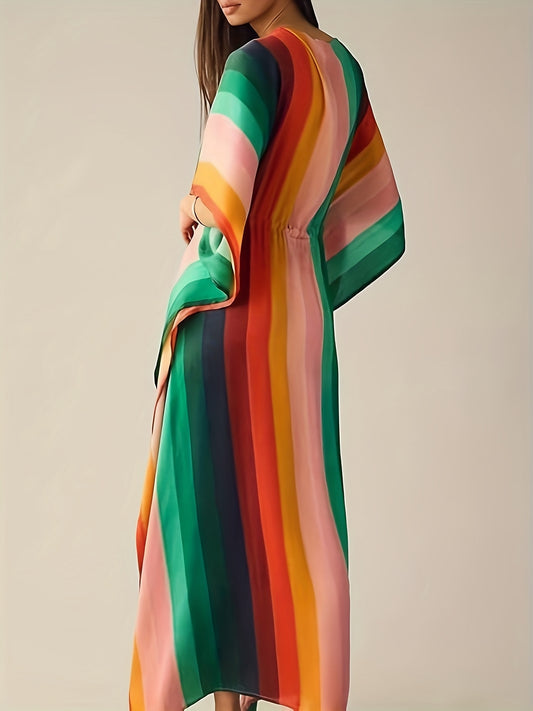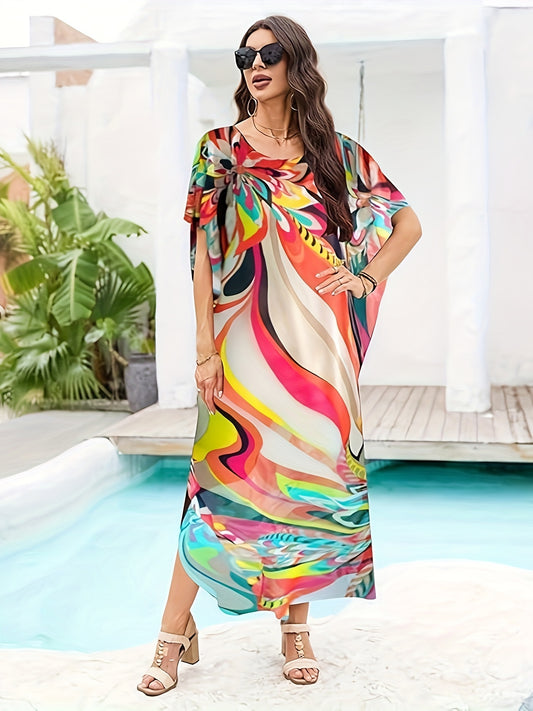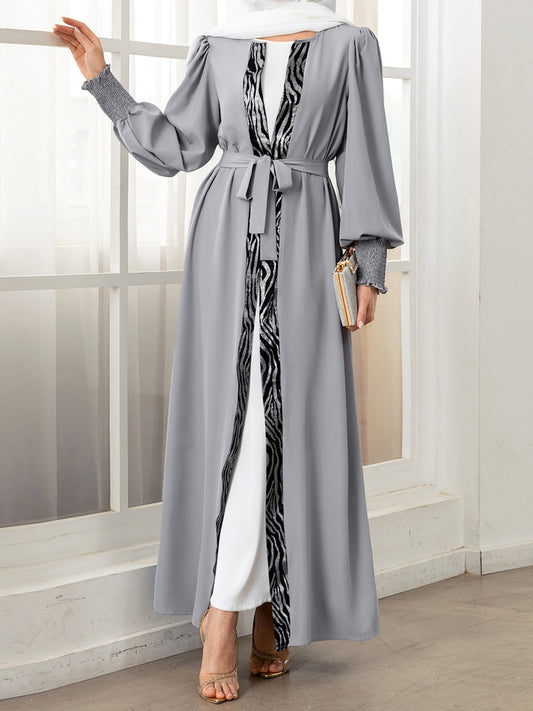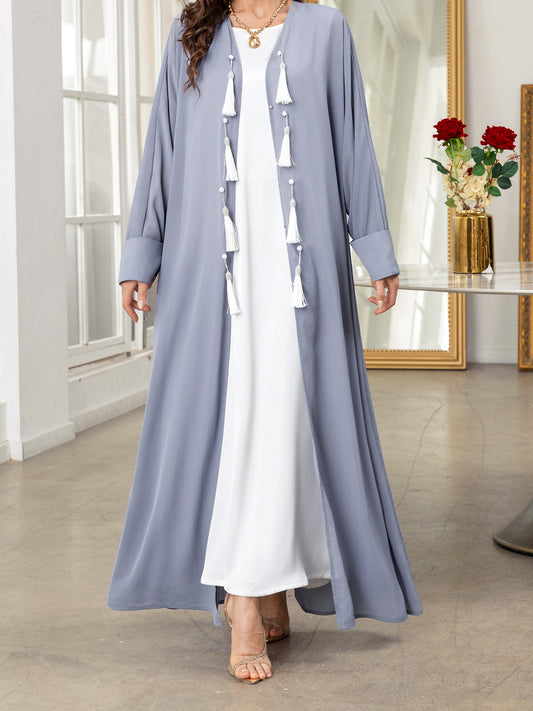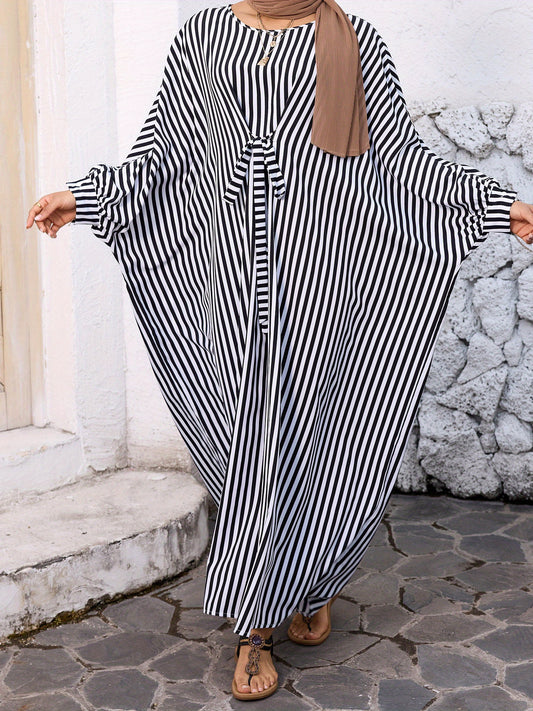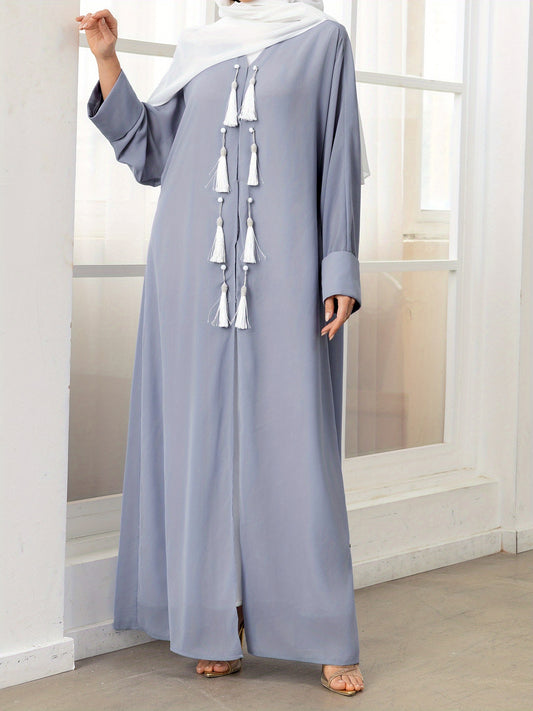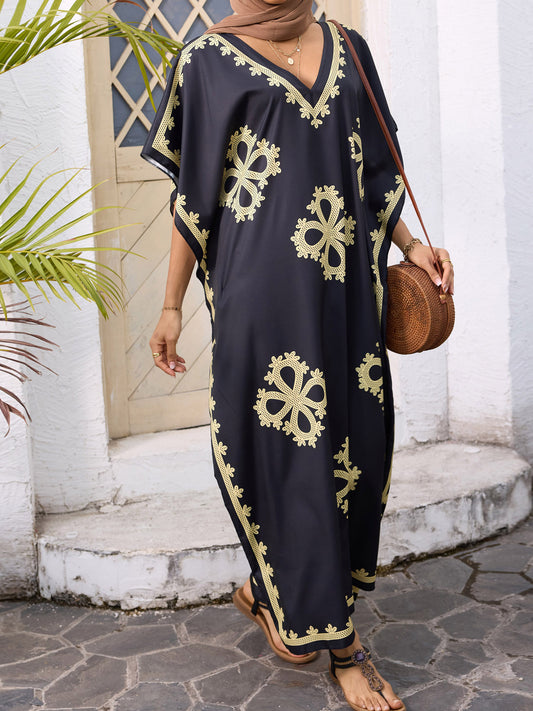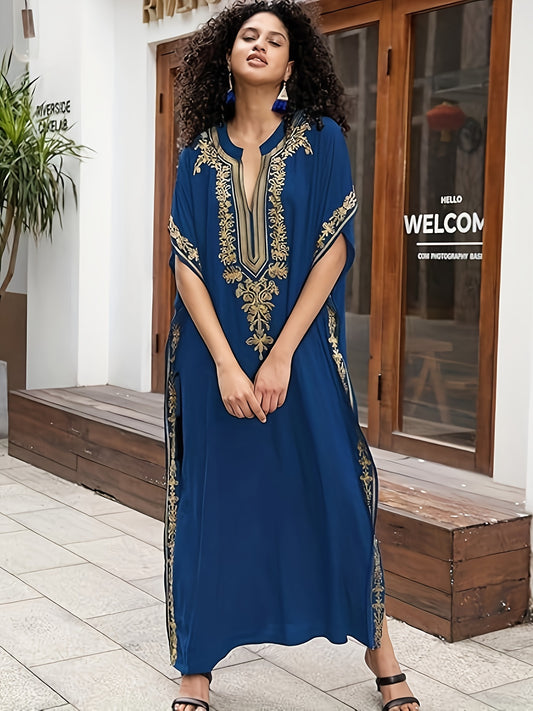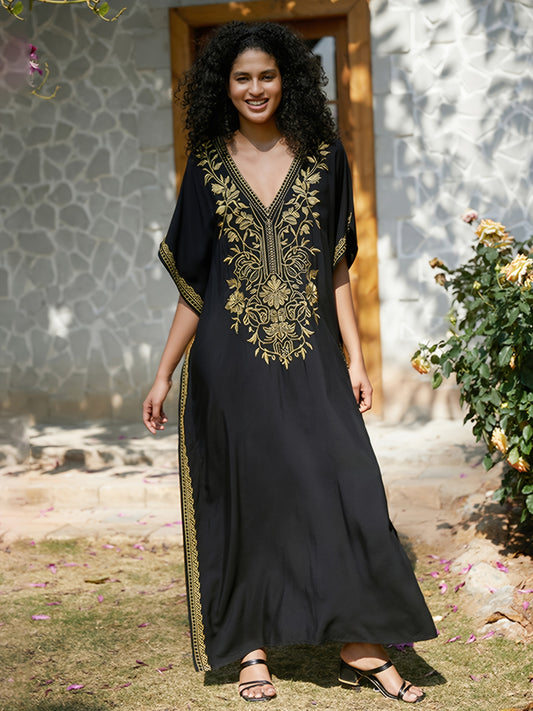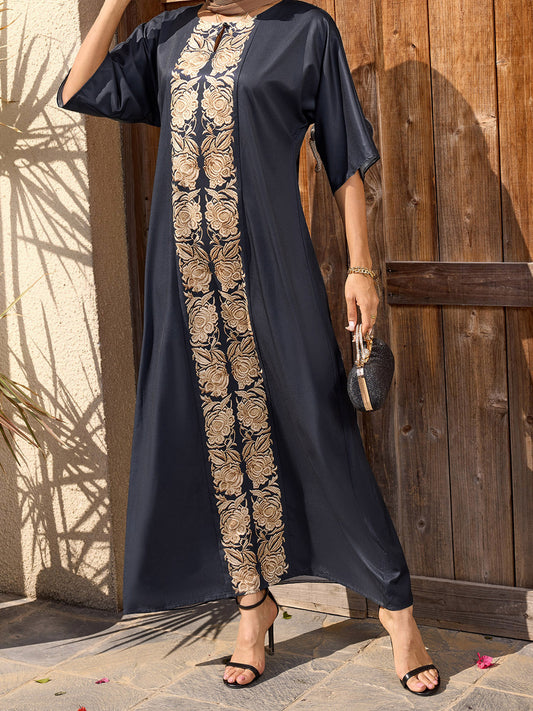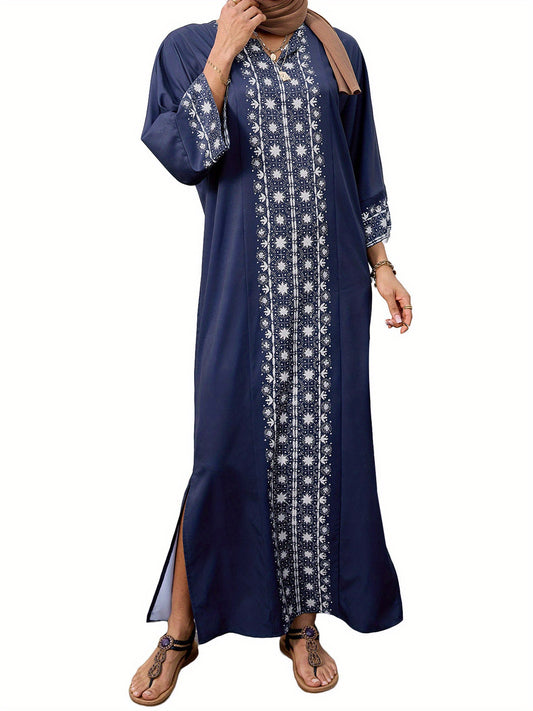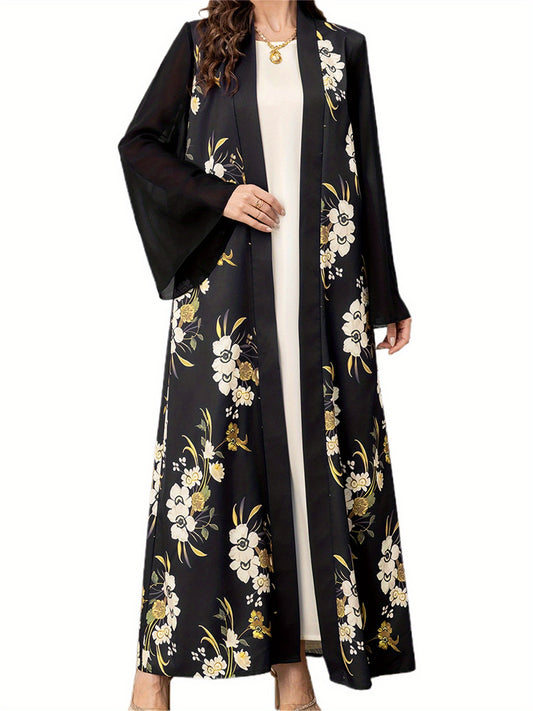The Complete Guide To Kaftans
Origins And Essence Of The Kaftan
Introduction To The Kaftan As A Timeless Silhouette
The kaftan is more than a garment; it is an evolving language of style. Defined by its generous cut, floating drape, and unforced elegance, it slips over the head and frames the body with dignity and ease. Unlike fitted dresses that impose structure, the kaftan creates space—both literal and symbolic. The cloth does not cling; it hovers, inviting air circulation in warm climates and layering potential in cooler ones. This balance of comfort and elegance explains why the kaftan has transcended centuries, geographies, and aesthetic movements.
In contemporary wardrobes, the kaftan thrives because it adapts to context. A lightweight cotton voile version suits sunlit resorts, while a silk crepe style paired with sculptural jewelry belongs under chandeliers at evening galas. Its ability to slip seamlessly between beachwear, cocktail attire, and relaxed loungewear makes it an indispensable element for cosmopolitan dressing. Unlike trend-driven pieces, the kaftan maintains credibility in every decade, proving that when form is well-considered, fashion never expires.
The Psychology Of Ease
Part of the kaftan’s charm lies in how it makes the wearer feel. Its volume releases the body from the rigid expectations of tailoring or the self-consciousness of clingy fabrics. This sense of freedom becomes psychological armor: the wearer feels elegant yet unconfined, sophisticated yet comfortable. In societies that constantly oscillate between productivity and performance, the kaftan offers respite without sacrificing polish. It is one of the rare garments where comfort becomes synonymous with style.
Fashion historians often describe the kaftan as a “bridge silhouette.” It connects opposites—modesty and sensuality, simplicity and luxury, tradition and modernity. That duality is central to its endurance. Women reach for kaftans not only to look beautiful but to experience presence: the comfort of inhabiting one’s body without restriction.
Historical And Cultural Origins
The genealogy of the kaftan stretches across continents. The earliest references appear in regions spanning North Africa, the Middle East, Anatolia, and Persia, later extending into the Indian subcontinent and West Africa. Each culture adapted the base form of a long, flowing garment to reflect its values, climate, and artistry.
-
Ottoman Empire: Ottoman sultans wore kaftans of brocaded silk, woven with gilt thread, displaying wealth and imperial power. These garments were not mere clothing but political statements—emblems of prestige presented to loyal officials or foreign dignitaries.
-
Maghreb and North Africa: Moroccan and Algerian traditions emphasized luminous color, intricate embroidery, and sfifa braids. The kaftan here was ceremonial, worn at weddings and religious festivals, embodying dignity and celebration.
-
Persia and Central Asia: In Persian courts, garden motifs and pomegranate symbols adorned kaftans, linking clothing to poetry and nature. Ikat-dyed fabrics from Central Asia contributed to the vocabulary of patterns still associated with kaftans today.
-
South Asia: The kaftan intersected with kurta and tunic traditions. Ajrak block printing in Sindh, resham embroidery in Gujarat, and bandhani dots became regional expressions of the flowing garment’s versatility.
-
West and East Africa: Parallel silhouettes such as the boubou and kanga established kaftans as signifiers of communal dignity. Bold wax prints and indigo resist fabrics transformed the garment into moving canvases of identity.
These regional vocabularies prove that the kaftan was never a static design but a traveling idea. Along trade routes, textiles and motifs mingled, producing hybrids that enriched the form without erasing its core premise of ease, coverage, and ceremony.
The Kaftan In The 20th Century
The 20th century witnessed the kaftan’s global revival. Colonial encounters, ocean liner travel, and artistic cross-pollination exposed European and American audiences to its possibilities. Designers reinterpreted it for cosmopolitan clients who sought exoticism tempered by modern practicality.
In the 1960s and 70s, the kaftan became a symbol of bohemian chic. Celebrities and socialites wore silk or velvet versions to cocktail parties, while resort communities embraced cotton and chiffon iterations as effortless holiday attire. Magazines captured images of women lounging in jewel-toned kaftans by Mediterranean pools, cementing the garment’s association with leisure, glamour, and international sophistication.
This revival also democratized the kaftan. What had been court dress or ceremonial attire transformed into a garment suitable for everyday cosmopolitan life. The adaptability of the silhouette—its ability to be minimal or ornate, sheer or opaque—explained its easy migration from private drawing rooms to public runways.
Contemporary Relevance
In today’s fashion ecosystem, the kaftan persists for several reasons:
-
Versatility: One garment functions across categories—daywear, resort wear, loungewear, eveningwear.
-
Cultural Resonance: It honors heritage while remaining open to reinterpretation, aligning with contemporary values of inclusivity and global dialogue.
-
Practical Elegance: The kaftan is climate-smart, travel-friendly, and body-positive. It flatters a wide range of figures without demanding tailoring.
-
Fashion Longevity: Unlike dresses tied to micro-trends, the kaftan avoids obsolescence. Photographs from decades apart show its continuity of relevance.
For these reasons, the kaftan is increasingly framed as a wardrobe investment rather than a passing indulgence. Luxury consumers appreciate its cost-per-wear logic: a silk crepe kaftan used across formal dinners, resort holidays, and cultural ceremonies provides better return than multiple trend dresses that quickly date.
The Kaftan As A Global Wardrobe Icon
Today, the kaftan is worn by women across continents, transcending religion, ethnicity, and lifestyle. In the Middle East, it appears in Ramadan wardrobes as both modest and celebratory attire. In Africa, it anchors formal occasions with bold wax prints and couture embroidery. In Europe and North America, it functions as both beach cover-up and high-fashion evening dress. In South Asia, it has been reinterpreted as casual daywear in cotton prints and glamorous partywear in embellished georgettes.
The garment’s fluidity across categories is unmatched. Few silhouettes can claim relevance in both minimalist and maximalist aesthetics. A black silk kaftan styled with geometric earrings feels modernist; the same silhouette embroidered in gold thread becomes ceremonial. That elasticity ensures that the kaftan will continue to resonate in future decades.
Emotional Resonance And Identity
Fashion is not only about appearance but also about identity. For many, the kaftan connects them to heritage. Wearing ajrak motifs or sfifa trims is not merely aesthetic; it is cultural continuity. For others, the kaftan offers liberation—a garment that hides and reveals with equal elegance. It allows the wearer to dictate how much of the body is seen, reasserting agency over modesty.
The kaftan also resonates with women navigating body diversity. Its floating cut does not impose a single body ideal. Petite women can hem it above the ankle to elongate, while curvier figures benefit from the sculptural play of volume. In an industry often accused of narrow standards, the kaftan remains democratic and affirming.
Design Principles, Silhouettes, And Materials
The Architecture Of A Kaftan
Every kaftan is an exercise in architecture. Though the garment appears effortless, its grace depends on carefully balanced proportions. Designers approach it as they would a building: manipulating line, negative space, and structural flow. A great kaftan does not overwhelm; it frames the body, letting the wearer remain the subject while the garment provides context. This is why the silhouette is described as “intentional volume.” The cloth floats but does not drown; it elongates rather than widens.
The guiding principles are proportion, line, and balance:
-
Proportion ensures that volume enhances, not disguises.
-
Line directs the eye vertically, diagonally, or horizontally, sculpting movement.
-
Balance reconciles comfort with sophistication—too much fabric reads heavy, too little loses drama.
Understanding this architecture is the first step in distinguishing a luxury kaftan from a generic tunic.
Core Silhouette Families
Three foundational silhouette families dominate the kaftan landscape. Each offers different moods, suited to lifestyle and occasion.
-
The Column
The straight column kaftan is architectural and disciplined. Falling directly from shoulder to hem, it creates a long vertical line that flatters petites and elongates tall figures further. This silhouette is favored for formal evenings, where simplicity conveys authority. Black silk crepe in column form becomes sculptural, especially when accessorized with minimal jewelry and high heels. -
The A-Line Flare
Here the kaftan opens gradually from shoulder to hem, forming a triangular sweep. This silhouette introduces drama without heaviness, allowing volume to flow gracefully as the wearer moves. Ideal for weddings or celebrations, the A-line kaftan often hosts embroidery or prints that radiate outward. It flatters fuller figures by skimming rather than clinging. -
The Cocoon Volume
This modern interpretation exaggerates fabric, creating an enveloping form. Cut with rounded seams or dropped shoulders, it embodies softness and ease. Cocoon kaftans are often chosen for resort or loungewear, where comfort reigns. In velvet or devoré, they can also deliver avant-garde glamour for gallery events.
The choice of silhouette dictates the garment’s identity, just as much as fabric or embellishment.
Necklines: The Focal Point
The neckline sets tone and frames the face. A jewel neckline emphasizes modesty; a bateau adds sophistication; a V-neck elongates the neck and is universally flattering. Split-necklines communicate relaxed elegance, while high mandarin collars signal modernist rigor. Many kaftans incorporate embroidery or beading around the neckline, anchoring the gaze at the face and allowing the body to dissolve into flowing fabric.
Luxury labels such as Fabulive favor necklines that remain versatile—subtle enough for day, elevated enough for evening—because versatility expands the garment’s lifecycle.
Sleeves: Language Of Movement
Sleeves determine how a kaftan moves. Kimono sleeves, cut in one with the body, create continuous flow. Angel sleeves add theatrical flair, widening as they fall. Bracelet sleeves showcase jewelry and free the hands for dining or writing. Cut-on sleeves with minimal underarm seaming enhance comfort in hot climates. Designers often engineer micro-elastic or hidden snaps at cuffs to allow adjustability without disrupting line.
Sleeves also serve symbolic purpose. In many cultures, wide sleeves indicate dignity, while in modern fashion, they convey effortlessness. By adjusting sleeve volume, designers recalibrate the kaftan’s energy—from languid to commanding.
Side Slits And Strategic Lengths
The slit is one of the kaftan’s quiet revolutions. By opening fabric at the side, designers allow stride and airflow while keeping the overall line modest. Slits can be subtle (mid-calf) or dramatic (up to the thigh for evening). Reinforced with bar tacks, they resist stress from walking and sitting.
Length is equally strategic:
-
Ankle-length signals ceremony and presence.
-
Midi-length suits modern urban life, bridging day and night.
-
Mini-length works for resort layering, often paired with swimwear.
These variations ensure the kaftan can be both timeless and trend-responsive.
Print Placement As Architecture
Print is not random decoration; it is structural. Designers place motifs to control how the garment reads. A central medallion anchors attention at the chest. Vertical vines elongate. Shadow borders at hems ground movement. Diagonal motifs tilt the figure forward, suggesting motion.
In luxury kaftans, prints are engineered, not cut haphazardly. Borders align at seams; motifs mirror at center fronts. This precision distinguishes elevated craft from mass-market shortcuts. For clients, it ensures that every photograph captures symmetry and harmony.
The Language Of Fabrics
Fabric is the soul of a kaftan. The same silhouette behaves differently in different textiles.
-
Silk Crepe: Fluid, springy, luminous. Ideal for evening and black-tie events. Moves like water.
-
Georgette: Matte, with a grainy hand. Diffuses light beautifully, photographs without glare.
-
Chiffon: Sheer, ethereal, ideal for layering. Needs lining or slips for opacity.
-
Cotton Voile/Lawn: Crisp, breathable, perfect for tropical heat. Casual elegance.
-
Linen Blends: Cool, textural, timeless. Works for resort capsules.
-
Viscose/Tencel: Sustainable, breathable, wrinkle-resistant. A traveler’s ally.
-
Velvet Devoré: Rich, dramatic, suited to winter events. Captures light in pattern.
-
Fine Wool Gauze: Lightweight warmth, transitional across seasons.
Designers exploit drape characteristics: heavy crepe sharpens outline; voile creates cloudlike movement; satin-back crepe traps warmth for cool evenings.
Surface Treatments: From Minimalism To Ceremony
Surface detailing transforms a simple kaftan into a ceremonial object.
-
Embroidery: From Moroccan sfifa braids to South Asian resham threads, embroidery adds texture and narrative.
-
Beadwork: Applied with thread guards for security, beads create shimmer without weighing fabric down.
-
Zardozi And Mirror Work: Elevate kaftans into bridal territory, catching light from every angle.
-
Digital Printing: Enables crisp artwork, efficient dye usage, and modern motifs.
-
Discharge Printing: Reveals lighter grounds beneath darker surfaces, producing luminous depth.
Placement is crucial: neckline, cuffs, and hems stabilize the cloth visually. Random ornament overwhelms; considered ornament dignifies.
Minimalism Versus Maximalism
The kaftan can speak two dialects: quiet luxury and maximalist spectacle. Minimalist kaftans in solid crepes or voiles rely on silhouette purity, appealing to modernist sensibilities. Maximalist kaftans revel in embroidery, metallic threads, or saturated prints, echoing ceremonial traditions. Fabulive’s curation acknowledges both, ensuring clients can build capsules that cover restrained professional codes and exuberant celebrations alike.
The Science Of Breathability And Comfort
Luxury clients demand not only beauty but also performance. Breathability is critical, particularly in tropical or arid climates. Fiber content, yarn twist, and weave density determine how air circulates and moisture wicks. Cotton voile allows convective cooling; viscose absorbs humidity; linen disperses heat through hollow fibers. Silk, while less breathable, delivers unrivaled drape and evening credibility.
Designers engineer kaftans by matching fabric to context: voile for summer city dressing, crepe for transitional evenings, velvet devoré for winter ceremonies. This textile intelligence ensures the garment performs as well as it photographs.
Why Fabulive Prioritizes Fabric Integrity
In a market crowded with synthetic blends, Fabulive distinguishes itself through fiber honesty. Collections emphasize natural and semi-synthetic fibers that balance drape with responsibility. Clients can expect cottons that remain crisp after washes, silks that hold color depth, and viscose blends that survive long-haul travel. By privileging integrity over shortcuts, Fabulive ensures that each kaftan remains beautiful not only at purchase but through repeated seasons.
Engineering, Functionality, And Regional Variations
The Hidden Engineering Of Effortlessness
To the untrained eye, a kaftan looks like pure simplicity—a flowing garment that appears to require no effort. But in reality, refined kaftans conceal a complex layer of engineering. Luxury design is never careless; the easiest garment to wear is often the hardest to construct.
-
Shoulder Slopes: A subtle slope keeps the garment from sliding off the shoulders, distributing fabric weight evenly. Without this, kaftans look sloppy or require constant adjustment.
-
Neckline Stabilization: Facing, bias binding, or interfacing stabilizes the neckline, preventing stretching with repeated wear.
-
Interior Ties: Many high-quality kaftans include discreet internal ties that cinch the waist invisibly, allowing the wearer to adjust shape without disrupting exterior minimalism.
-
In-Seam Pockets: Pockets are engineered to sit flat so they don’t distort silhouette. In ceremonial kaftans, pockets are often omitted to preserve purity of line.
-
Micro-Elastic At Cuffs: A detail that allows adjustability for bracelet-length sleeves while maintaining elegance.
-
Side Slit Reinforcement: Bar tacks at stress points prevent tearing when walking or sitting.
These refinements distinguish a luxury kaftan from a mass-produced one. When turned inside out, true craftsmanship reveals itself in clean seams, tidy finishes, and aligned motifs.
Functionality In Climate And Movement
Kaftans thrive because they perform across climates and geographies. In desert heat, loose fabric creates airflow around the body. In humid tropics, lightweight cotton or viscose wicks moisture, keeping the body cool. In Mediterranean evenings, silk or crepe balances elegance with comfort. In temperate zones, kaftans layer seamlessly over knits or trousers.
Movement is equally important. The garment is designed to travel with the wearer—whether stepping into a ceremonial hall, lounging on a veranda, or crossing airport terminals. Side slits allow stride; generous cuts prevent restriction; fabrics chosen for drape prevent bulk. This blend of elegance and practicality ensures the kaftan’s survival as a global icon.
Travel-Ready Performance
Frequent travelers know the value of garments that emerge from luggage ready to wear. Designers engineer kaftans from wrinkle-resistant viscose crepes or matte twills that can be rolled, not folded, and revived with a handheld steamer in minutes. Silk versions are often lined with lightweight georgette to reduce cling and add structure during long dinners. Cotton voile pieces pack flat and recover easily after a wash, making them ideal for extended resort stays.
Travel performance also includes adaptability. A single kaftan in matte crepe can be styled as a poolside cover-up by day and transformed with jewelry into eveningwear. This multifunctionality reduces packing volume, reinforcing the kaftan’s role as a capsule wardrobe essential.
Regional Variations: A Cultural Tapestry
While the base form remains consistent, regional interpretations give the kaftan cultural specificity.
North Africa And The Maghreb
Moroccan kaftans are famed for jewel tones, metallic embroidery, and sfifa trims. They often appear in weddings, where brides wear elaborately layered versions called takchita. Algerian styles emphasize bold embroidery, while Tunisian variations lean into fine cottons suited to hot climates. In all cases, the kaftan is ceremonial, connecting family celebrations with centuries of craft.
The Levant
In Jordan, Syria, and Palestine, kaftans often incorporate geometric embroidery, reflecting regional textile vocabularies. These versions use fine lawn or cotton for daytime, while eveningwear leans into silks or chiffons with restrained ornament. The emphasis is balance: refinement without excess, elegance rooted in geometry.
Turkey And Anatolia
Ottoman influence remains visible in striped silks, metallic ribbons, and ikat patterns. Historically associated with courts and sultans, Turkish kaftans signaled authority and wealth. Today, designers reinterpret these textiles for global audiences, creating contemporary kaftans that reference heritage without being literal.
Persia And Central Asia
Persian aesthetics favor motifs of gardens, florals, and pomegranates. Kaftans here were poetic garments, evoking abundance and fertility. Central Asian ikats, with their blurred edges, became part of the kaftan’s vocabulary. These designs carry cultural symbolism while also appealing to modern minimalists who value organic geometry.
South Asia
South Asia adapted the kaftan into daily and ceremonial life. Cotton block-printed kaftans function as daywear in hot climates, while embellished georgette and silk versions become evening staples. Ajrak, bandhani, and gota lace are common adornments. In India and Pakistan, kaftans are now staples of festive wardrobes, appreciated for both comfort and glamour.
West And East Africa
Parallel silhouettes like the boubou in West Africa or kanga in East Africa echo kaftan principles. Wax prints, indigo resist fabrics, and dramatic sleeve profiles characterize these versions. The kaftan here is both communal and personal: a garment of dignity, celebration, and identity. Contemporary African designers continue to innovate, marrying couture techniques with local textiles to global acclaim.
Mediterranean And European Resorts
In Mediterranean culture, white linen or nautical-striped kaftans became synonymous with leisure. By the 1960s, European jet-setters adopted the kaftan as a symbol of Riviera chic, immortalized in photographs of women on yachts or terraces. Today, these influences inform resort capsules where kaftans in lightweight cotton or viscose remain essential.
Motif Symbolism Across Cultures
Motifs embedded in kaftans often carry meaning beyond decoration:
-
Pomegranates: Fertility and abundance (Persian).
-
Geometric Borders: Protection and order (Levant).
-
Floral Gardens: Connection to paradise or nature (Persia, South Asia).
-
Ikat Blurs: Movement and transformation (Central Asia).
-
Wax Print Patterns: Communal storytelling (West Africa).
For clients building investment wardrobes, understanding these motifs enriches ownership. Each kaftan becomes not just a garment but a narrative thread connecting history, geography, and craft.
Modern Interpretations And Fusion
Today’s designers remix these regional dialects with contemporary aesthetics. A Moroccan sfifa trim might appear on a matte crepe kaftan designed for Western eveningwear. A South Asian ajrak block print might be digitally translated onto silk chiffon for resort capsules. African wax print motifs might inspire engineered borders in luxury viscose for global clients.
Fabulive, for example, curates kaftans that respect tradition while offering modern versatility. A client purchasing from Fabulive knows she is wearing not only fabric but also a story—a garment that travels across time and geography to meet her in the present.
Functionality For Diverse Lifestyles
Functionality ensures the kaftan is not confined to occasion wear. In professional contexts, matte crepe midis with minimal prints project authority. For mothers, cotton voile kaftans offer ease for daily movement while remaining chic. For travelers, viscose blends provide durability and wrinkle resistance. For brides, silk crepe with subtle embroidery becomes heirloom.
Design variety ensures that every lifestyle finds a match. A woman may own multiple kaftans—some ceremonial, some casual, some resort-ready—but all reflect the same promise: effortlessness balanced with dignity.
Styling, Occasions, And Lifestyle Integration
The Kaftan As A Styling Framework
One of the kaftan’s greatest strengths is its adaptability. Unlike garments bound to a single occasion, the kaftan is a shape-shifter, recalibrating with fabric, accessories, and intent. A cotton voile kaftan with leather sandals reads casual and effortless, while a silk crepe version styled with sculptural jewelry reads ceremonial. By mastering styling frameworks, the wearer unlocks the kaftan’s full potential across life’s diverse scenarios.
Luxury styling is not about quantity but about versatility. A well-curated kaftan capsule can serve offices, vacations, family gatherings, and formal events with minimal overlap. This fluidity is why fashion editors often describe the kaftan as “one silhouette, infinite outputs.”
Everyday Styling Frameworks
The modern woman navigates multiple contexts in a single week—work, social, travel, leisure. The kaftan answers all, provided it is styled with precision.
-
Creative Office: Choose a matte crepe midi kaftan in a restrained palette (navy, charcoal, ivory). Add a leather belt to define the waist, a structured tote, and minimal gold hoops. Footwear: block-heel sandals or polished flats. The effect: authoritative yet original.
-
Weekend Ease: A cotton voile kaftan in stripes or micro-floral, styled with espadrilles, straw hat, and woven crossbody bag. Sunglasses complete the look. The effect: relaxed chic for markets, brunches, or garden strolls.
-
Resort Capsule: A sheer chiffon kaftan layered over swimwear transitions from poolside to terrace dining. Add leather slides, shell jewelry, and a raffia clutch. The effect: polished leisure without overpacking.
-
Evening Polished: A silk crepe or velvet devoré ankle-length kaftan with statement earrings, sleek clutch, and strappy heels. Hair styled in a bun or waves. The effect: glamorous but unforced, commanding presence without armor.
Each framework balances practicality with intent. Accessories and fabrics do the heavy lifting; the silhouette remains constant.
Occasion-Specific Styling
Weddings And Family Celebrations
The kaftan thrives at weddings, where comfort meets elegance. Brides may choose ivory silk kaftans with subtle beadwork for pre-wedding rituals. Mothers of the couple appreciate coverage that looks chic without heaviness. Guests may select jewel-toned georgettes with embroidery, paired with metallic sandals and chandelier earrings. The kaftan allows long hours of socializing and dining without discomfort.
Travel And Holiday Dressing
Travelers appreciate wrinkle-resistant viscose kaftans that double as day and evening wear. A single ankle-length piece in matte crepe can serve as airport attire (with slides and crossbody) and dinner wear (with heels and cuff bracelet). Kaftans roll easily into carry-ons and refresh with steam, making them indispensable for resort wardrobes.
Professional And Stage Settings
In client-facing roles, matte crepe midis with restrained prints strike balance between personality and authority. Paired with structured totes and block-heel mules, the look is decisive yet approachable. On stage, designers recommend matte fabrics (to avoid glare under lights), bracelet sleeves (to frame microphones), and saturated solid colors that read confidently in photographs.
Black-Tie And Gala
The kaftan proves its range by excelling at black-tie events. A black silk crepe column with satin binding, accessorized with crystal earrings and sleek slingbacks, becomes architectural. Alternatively, a jewel-toned velvet devoré with metallic heels offers depth and drama. Unlike fitted gowns, these kaftans allow comfort throughout evening dinners and dancing.
Accessory Strategies
Accessories multiply the kaftan’s possibilities. Because the silhouette is streamlined, even small changes create significant impact.
-
Belts: Leather belts define the waist and reprogram volume into tailored presence. Beaded or metallic sashes create festive energy. Placement slightly above natural waist elongates.
-
Jewelry: Hammered cuffs or sculptural earrings modernize daytime cottons; crystal chandeliers elevate silk for evening. Jewelry placement is strategic: earrings frame the face when neckline is minimal, cuffs shine when sleeves are bracelet length.
-
Bags: Slim clutches for formal events, medium totes for day, woven crossbody for travel. Proportion matters: oversized bags compete with flowing lines, structured bags sharpen them.
-
Shoes: Leather slides for weekend, espadrilles for resort, block-heel sandals for creative office, jeweled flats for cultural ceremonies, strappy heels for gala. Footwear shifts tone instantly.
-
Headwear: Silk bands, turbans, or scarves add cultural resonance and practical flair, framing the face while managing hair in humidity.
By rotating accessories, one kaftan can serve five roles without redundancy.
Modularity With Wardrobe Pieces
The kaftan does not exist in isolation; it integrates seamlessly into broader wardrobes.
-
With Trousers: Worn over tailored trousers, a midi kaftan becomes an elongated tunic suitable for creative offices.
-
With Knits: Layered over slim turtlenecks, kaftans gain architectural dimension for winter.
-
With Swimwear: Sheer kaftans double as cover-ups, transitioning from poolside to terrace dining.
-
With Coats: A long tailored coat over a silk kaftan creates sculptural winter eveningwear.
This modularity increases cost-per-wear efficiency, reinforcing the kaftan’s role as a wardrobe keystone.
Lifestyle Capsules
The Creative Professional
Wardrobe logic: matte crepe midis, restrained prints, leather belt, modern hoops, structured tote, block-heel sandals. Capsule of three kaftans can rotate across office, gallery events, and travel.
The Resort Traveler
Wardrobe logic: wrinkle-resistant viscose maxis, lightweight chiffons, straw accessories, shell jewelry, espadrilles. A two-kaftan capsule covers a week of dinners and poolside relaxation.
The Minimalist
Wardrobe logic: three timeless kaftans—one cotton voile for daytime, one silk crepe for evening, one viscose blend for travel. Neutral palette: black, ivory, navy. Accessories shift tone.
The Celebrant
Wardrobe logic: jewel-toned silk or embroidered georgette, metallic sandals, chandelier earrings, embroidered clutch. Perfect for weddings, festivals, or cultural milestones.
These lifestyle capsules reduce decision fatigue while preserving style integrity.
Body Diversity And Confidence Styling
The kaftan affirms body diversity with grace. Petite clients benefit from ankle hems and vertical motifs; tall clients lean into dramatic lengths and bold prints. Curvier figures flourish in A-line silhouettes that sculpt rather than conceal. V-necks elongate the neckline; bracelet sleeves showcase wrists. Side slits release volume for easier stride.
Importantly, the kaftan carries psychological power: it liberates women from rigid dress codes or body ideals. Whether styled casually or ceremonially, it offers presence without self-consciousness.
Photography And Event Lighting
In the age of digital storytelling, clothing must perform for the camera as well as the room. Kaftans adapt well, but fabric choice matters.
-
Silk Crepe: Reads rich and dimensional in photographs.
-
Chiffon: May appear sheer under LED; pair with slips.
-
Velvet Devoré: Captures light dramatically but should be tested against flash photography.
-
Prints: Avoid small high-contrast patterns that “strobe” on video; favor larger or engineered motifs.
Testing under event lighting ensures that the kaftan photographs as luxuriously as it feels.
The Kaftan As Wardrobe Algorithm
Ultimately, the kaftan becomes a wardrobe algorithm: one silhouette, infinite adaptations. By building capsule strategies—day, evening, travel, ceremony—women reduce wardrobe noise while increasing style credibility. Every photograph, every occasion, every journey benefits from a garment that combines elegance with ease.
Care, Sustainability, And Buyer’s Guide
The Relationship Between Care And Longevity
A kaftan may appear simple, but like any luxury garment, its lifespan depends on mindful care. Fabrics such as silk, chiffon, and velvet are delicate by nature, while breathable cotton and linen, though sturdier, demand proper laundering to retain crispness. Luxury is not defined only by purchase; it is defined by how long a garment remains beautiful. When cared for attentively, a kaftan endures across years, becoming a wardrobe mainstay rather than a seasonal novelty.
Good care routines also reinforce sustainability. By extending the life of each garment, owners reduce the need for frequent replacements. A kaftan that looks as elegant in its fifth season as it did on day one embodies the true logic of investment dressing.
Laundering Protocols By Fabric
-
Silk Crepe And Satin-Back Crepe
Dry clean with a trusted specialist, or hand wash with a silk-safe cleanser in cool water. Avoid twisting; instead, press gently in a towel and air dry flat. Use a garment steamer or a cool iron from the reverse side. -
Chiffon And Georgette
Hand wash delicately in a mesh bag with a mild cleanser. Roll in a towel to remove excess water. Steam to revive drape. Avoid excessive rubbing, which may cause snagging. -
Cotton Voile And Lawn
Machine wash on delicate in cold water. Line dry to preserve freshness. Lightly press with a warm iron for crispness. Avoid tumble-drying, which can weaken fibers. -
Linen Blends
Machine wash warm. Steam while slightly damp to relax creases. Accept natural texture as part of luxury character—perfectly flat linen reads lifeless. -
Viscose And Tencel
Machine wash on delicate, reshape while damp, and dry flat. Press gently with a cool iron. These fabrics reward care by retaining drape and sheen. -
Velvet Devoré
Specialist cleaning only. Store flat with tissue between folds to avoid pressure marks. Avoid hanging, which may distort pile.
By respecting these protocols, a kaftan not only retains beauty but also performs better in photography and wear.
Storage And Travel Care
Proper storage preserves both structure and embellishment.
-
Padded Hangers: Prevent stretching at the shoulders, especially for silk and georgette.
-
Breathable Bags: Cotton garment bags protect against dust without trapping moisture.
-
Flat Storage: For heavily beaded or velvet devoré kaftans, store flat with acid-free tissue to avoid distortion.
-
Travel Rolling: Roll instead of fold to minimize creasing. Upon arrival, hang in a steamy bathroom to release wrinkles.
Travel-friendly kaftans in matte crepe or viscose are especially valued by frequent flyers—they emerge from carry-ons nearly ready to wear.
Repair And Aftercare
Even the best kaftans encounter wear. Seams can stretch, beads may loosen, hems may need re-stitching. Luxury ownership includes willingness to repair.
-
Seam Repairs: Straight seams can be reinforced by a tailor.
-
Beadwork: Loose beads should be re-anchored with strong thread guards.
-
Color Fading: Overexposed cottons can be re-dyed into deeper shades to extend life.
-
Alterations: Straight side seams make size adjustments feasible, ensuring kaftans adapt to changing bodies.
Small investments in aftercare extend garment relevance, reduce waste, and enhance sentimental value.
Climate And Performance Strategies
Kaftans interact with climate in distinct ways:
-
Humid Tropics: Choose cotton voile, viscose, or Tencel for moisture-wicking. Underarm gussets reduce abrasion.
-
Arid Heat: Linen disperses warmth effectively. Light colors reflect sun, reducing heat absorption.
-
Cool Evenings: Satin-back crepe or velvet devoré paired with lightweight knits adds insulation without bulk.
-
Winter Cities: Layer kaftans under tailored coats with tights and boots. Silk and matte crepe retain polish indoors.
Understanding these performance strategies ensures kaftans remain practical, not just beautiful.
Sustainability And Traceability
The kaftan’s future lies in sustainability. Clients now expect transparency: where fibers are grown, how fabrics are dyed, and whether artisans are paid fair wages.
-
Preferred Fibers: Organic cotton, low-irrigation linen, Lenzing-certified viscose, peace silk, and recycled polyester chiffons.
-
Low-Impact Dyes: Digital and reactive printing reduce water usage compared to traditional vat methods.
-
Craft Communities: Supporting block printers, embroiderers, and weavers ensures continuity of endangered skills.
-
Packaging: Recycled paper tags and plant-based polybags minimize waste.
By choosing responsibly made kaftans, clients align elegance with ethics. The garment becomes not only a fashion statement but a conscious purchase.
Cost-Per-Wear Logic
Investment logic frames the kaftan as more economical than fast fashion. A silk crepe kaftan may cost more initially, but when worn across weddings, galas, and resort dinners, its cost-per-wear falls dramatically.
Example:
-
Price: $600
-
Worn 12 times across a year → $50 per wear
-
Compared to a $150 fast-fashion dress worn twice → $75 per wear
The kaftan’s adaptability multiplies this value. Few garments can pivot from professional authority to cultural ceremony as seamlessly. For clients building investment wardrobes, the kaftan is one of the smartest allocations.
Buyer’s Guide: Evaluating Quality
When purchasing a kaftan, inspect the following:
-
Fabric Pedigree: Is silk authentic? Is cotton organic? Is viscose Lenzing-certified?
-
Construction: Are seams even, neckline facings smooth, slits reinforced with bar tacks?
-
Print Placement: Do motifs align at seams and mirror at center front? Misaligned prints signal shortcuts.
-
Embellishment: Are beads anchored securely with knots and thread guards? Does embroidery lie flat?
-
Sizing: Are measurement charts transparent? Does the garment grade proportionally across sizes?
-
Care Label Accuracy: Does the brand provide realistic laundering advice? Luxury integrity is also honesty.
Running this audit ensures that the kaftan delivers on both beauty and durability.
Extended FAQs
Can I tailor a kaftan?
Yes. Straight side seams and clean hems allow easy alterations. Hemming is straightforward, sleeve adjustments manageable.
What slip should I wear under sheer fabrics?
A bias-cut viscose slip in a tone close to your skin provides comfort and invisibility.
Does a kaftan suit petite frames?
Absolutely. Hem above the ankle, favor vertical motifs, and add a belt to elongate.
How many kaftans do I need?
A minimalist capsule often requires three to four: daytime cotton, polished day crepe, travel-ready viscose, and one evening silk.
Can I belt a kaftan without ruining its line?
Yes. Use soft sashes or slim leather belts placed slightly above the waist to preserve exterior flow.
Is the kaftan appropriate in cold climates?
Yes. Layer over thermal knits, add opaque tights, and select heavier fabrics such as crepe or velvet.
Return On Style
The kaftan’s resilience across decades proves its staying power. Unlike dresses tied to fleeting trends, the kaftan relies on proportion, fabric, and cultural resonance. Wardrobes built with kaftans age gracefully—photographs from five or ten years ago still look relevant.
For clients who prioritize return on style, the kaftan offers unmatched value. A carefully curated set of four kaftans—a cotton for day, a silk for evening, a viscose for travel, and an embroidered piece for ceremony—covers 80% of lifestyle scenarios. This efficiency makes it both a luxury and a practical cornerstone.
Fabulive’s Promise, Investment Value, And Customer Experiences
The Fabulive Philosophy
In a market crowded with fast-fashion imitations, Fabulive curates kaftans with deliberate integrity. Every piece is designed to bridge cultures and occasions while upholding standards of fabric quality, finishing, and ethical sourcing. Where other labels rely on fleeting trends, Fabulive insists on continuity—kaftans that endure from season to season, not only because of craftsmanship but also because they are designed for real lives.
-
Fabric Integrity: Prioritizing breathable natural fibers, Lenzing-certified viscose, and responsibly sourced silks.
-
Finishing Discipline: Clean hems, reinforced slits, secure beadwork, and aligned prints are non-negotiable.
-
Size Inclusivity: Measurement charts and proportional grading ensure that women of all body types find elegance without compromise.
-
Seasonless Design: Pieces designed to travel across climates, from humid tropics to winter evenings.
-
Transparency: Sharing sourcing stories and spotlighting artisan communities.
This philosophy ensures that a Fabulive kaftan is not just a garment but a long-term investment—one that respects both the wearer and the makers.
Wardrobe Math And Capsule Mapping
Approaching the kaftan as a wardrobe cornerstone requires strategy. A complete capsule spans four functional lanes:
-
Off-Duty Ease
Fabrics: cotton voile, linen blends.
Styling: flat sandals, woven bags.
Function: errands, casual weekends, resort city strolling. -
Work-Polished
Fabrics: matte crepe, viscose blends.
Styling: belts, block-heel sandals, structured totes.
Function: creative offices, presentations, cultural events. -
Ceremonial And Celebration
Fabrics: silk crepe, georgette with embroidery, velvet devoré.
Styling: chandelier earrings, jeweled flats, metallic clutches.
Function: weddings, festivals, evening receptions. -
Travel-Proof
Fabrics: wrinkle-resistant twill, viscose crepe.
Styling: slides, crossbody bags, versatile jewelry.
Function: airport-to-dinner continuity, long-haul capsules.
With as few as four kaftans—one in each lane—clients cover 80% of lifestyle scenarios. Accessories shift tone, multiplying outputs without requiring constant wardrobe expansion.
Resale, Alteration, And Archival Value
A quality kaftan retains value because it resists timestamping. Solid silks, engineered prints, and meticulous embroidery remain desirable years later, especially when sold with original garment bags or care notes.
-
Resale Value: Online luxury resale markets reward garments with clear provenance, intact finishing, and timeless motifs.
-
Alteration Potential: Straight seams and untrimmed hems allow tailoring for new owners, extending lifespan.
-
Archival Sentiment: Ivory silk bridal kaftans, ceremonial embroidered heirlooms, or limited-edition prints can be archived in breathable cotton bags. Documenting their story enhances generational value.
A kaftan becomes more than a garment—it becomes part of a personal archive of life events, memories, and celebrations.
Extended FAQs
Is a kaftan appropriate for formal black-tie events?
Yes. Choose silk crepe or velvet, pair with metallic heels and statement jewelry. Engineered prints and restrained beadwork elevate without overwhelming.
How do I ensure online colors are accurate?
Check product photos across devices, read shade descriptions carefully, and consult video if available. Natural daylight images are most reliable.
Can I wear a kaftan in winter?
Absolutely. Pair with opaque tights, boots, and a tailored coat. Heavier fabrics such as crepe or velvet offer warmth while retaining elegance.
What if I am petite?
Hem to the ankle, favor vertical motifs, and choose V-necks to elongate the frame. Petite figures can also experiment with micro-prints and slimmer sleeves.
Can kaftans be belted without distorting their flow?
Yes. Use slim belts or fabric sashes slightly above the natural waist. Many luxury kaftans feature interior ties that maintain exterior smoothness.
What accessories best complement minimal kaftans?
For day: hammered cuffs, leather slides, straw bags. For evening: crystal earrings, metallic sandals, sculptural clutches. Accessories reprogram minimalism into ceremony.
How many kaftans should form a core wardrobe?
Three to four cover most needs: daytime cotton, evening silk, travel-proof viscose, and one ceremonial embroidered piece.
Can kaftans accommodate body diversity?
Yes. Their fluid cut negotiates space and movement gracefully, flattering petite, tall, and curvier figures alike. Adjustments in hem and neckline personalize proportion.
Glossary Of Terms
-
Ajrak: Block-printed cloth from Sindh using indigo and madder.
-
Devoré: Burnout technique that creates velvet motifs on sheer grounds.
-
Gota: Metallic ribbon applique, popular in South Asia.
-
Ikat: Dyeing technique binding threads before weaving to create blurred patterns.
-
Sfifa: Moroccan braided trim, often metallic, used at edges.
-
Voile: Lightweight cotton fabric with airy hand.
Case Studies: Styling Scenarios
-
City Creative: Matte crepe midi, sculptural earrings, leather sneakers by day. Metallic sandals and cuff bracelet transform it for evening.
-
Resort Classic: Linen maxi with straw hat and espadrilles. Evening upgrade with silk scarf and pearl studs.
-
Formal Modernist: Black silk column kaftan, satin binding, crystal earrings, slingbacks. Sculptural bun for architectural effect.
Each case proves how a kaftan shifts seamlessly across settings without redundancy.
Fabulive’s Promise Of Continuity
Fabulive’s collections prove that luxury is not excess but refinement. Every kaftan undergoes stringent quality checks—aligned seams, tested dyes, secured embellishments—before reaching clients. Seasonless releases prioritize fabrics and motifs that remain timeless rather than trend-driven.
For Fabulive, continuity is not only about durability of garments but also about sustaining trust. Clients return because their kaftans wear beautifully, travel effortlessly, and age gracefully.
Customer Reviews
-
Sarah, USA
“I purchased a linen-blend kaftan from Fabulive for my Dubai trip and wore it nearly every day. It kept me cool, packed flat, and transitioned from market strolls to rooftop dinners. Even after multiple washes, the seams and color hold perfectly. A true travel essential.” ⭐⭐⭐⭐⭐ -
Leila, UK
“The silk crepe drape is exquisite. I wore it belted for a corporate dinner and felt elegant without being overdressed. Colleagues complimented the cut, and the photographs looked polished under restaurant lighting.” ⭐⭐⭐⭐ -
Amina, Canada
“My georgette kaftan from Fabulive is lined, so it remains opaque without heaviness. I styled it with sneakers during the day and swapped for bangles and heels at Eid. It feels like two dresses in one.” ⭐⭐⭐⭐⭐ -
Marta, Germany
“The velvet devoré kaftan was perfect for a winter wedding. It kept me warm with a coat outside and looked dramatic under candlelight inside. Several guests asked where it was from.” ⭐⭐⭐⭐ -
Noor, UAE
“As a new mother, I appreciate the discreet snap neckline—so practical for nursing while staying stylish at family gatherings. This detail made me a loyal client.” ⭐⭐⭐⭐⭐ -
Sofia, Italy
“The border print alignment is flawless. Even at the seams, the pattern continues seamlessly. It looks far more expensive than its price and feels like couture.” ⭐⭐⭐⭐⭐ -
Yasmin, Australia
“My viscose kaftan traveled beautifully to Sydney in summer. It was breathable, quick-drying, and revived instantly with steam. A wardrobe hero for long-haul flights.” ⭐⭐⭐⭐ -
Iman, France
“Customer service guided me through shoulder widths and sizing. The fit is relaxed but intentional—exactly as I hoped. It feels curated, not mass-produced.” ⭐⭐⭐⭐⭐ -
Hanna, Spain
“As someone 5'2”, I was worried it would overwhelm me. Fabulive suggested hemming just above the ankle. The proportion is now perfect, elongating my frame without losing flow.” ⭐⭐⭐⭐⭐ -
Omar, Saudi Arabia
“The fabric quality is undeniable, though I wish the side slits were a little higher for easier stride. Still, the kaftan feels luxurious and versatile for evening gatherings.” ⭐⭐⭐


